Now, then, and the future: Read the 75th Anniversary Issue
The DF-26 medium-range ballistic missile as seen after the military parade held in Beijing to commemorate the 70th anniversary of the end of WWII.
Nuclear notebook: Chinese nuclear forces, 2020
By Hans M. Kristensen, Matt Korda, December 7, 2020
Editor’s note: The Nuclear Notebook is researched and written by Hans M. Kristensen, director of the Nuclear Information Project with the Federation of American Scientists, and Matt Korda, a research associate with the project. The Nuclear Notebook column has been published in the Bulletin of the Atomic Scientists since 1987.
To download a free PDF of this article, click here.
To see all previous Nuclear Notebook columns, click here.
China is continuing the nuclear weapons modernization program that it initiated in the 1980s and increased in the 1990s and 2000s, fielding more types and greater numbers of nuclear weapons than ever before. Since our previous Nuclear Notebook on China in June 2019, China has continued fielding the DF-26—a dual-capable, mobile, intermediate-range ballistic missile (IRBM)—and is replacing older road-mobile DF-31A intercontinental ballistic missile (ICBM) launchers with the more maneuverable DF-31AG launcher. China is also in the process of fielding the new DF-41, a road-mobile ICBM that is thought to be capable of carrying multiple independently targetable reentry vehicles (MIRVs) like the old DF-5B. At sea, China has completed construction and deployment of two more ballistic missile submarines and is developing a new type. Additionally, China has recently reassigned a nuclear mission to its bombers and is developing an air-launched ballistic missile that might have nuclear capability.
We estimate that China has a produced a stockpile of approximately 350 nuclear warheads, of which roughly 272 are for delivery by more than 240 operational land-based ballistic missiles, 48 sea-based ballistic missiles, and 20 nuclear gravity bombs assigned to bombers. The remaining 78 warheads are intended to arm additional land- and sea-based missiles that are in the process of being fielded (see Table 1). This estimate is higher than the “low-200” warheads reported by the Pentagon in its 2020 report to Congress; however, the Pentagon’s estimate only refers to “operational” Chinese nuclear warheads, and therefore presumably excludes warheads that are attributed to newer weapons still in development (US Defense Department 2020a). It is also possible that the Pentagon’s estimate does not include dormant bomber weapons. Taking those categories into account, the Pentagon’s estimate is roughly in line with our own.

China Table 1
US estimates of Chinese nuclear weapons
The US declaration in 2020 that China has in the low-200s operational nuclear warheads was a surprise because the number was lower than expected and much lower than the many hundred—even thousands—of warheads that some have warned about in recent years (Heinrichs 2020, Howe 2020, Schneider 2019, Karber 2011). Although the low estimates have varied, they have generally been correct, while the higher estimates have been incorrect. When rumors about much higher estimates emerged nearly a decade ago, General Robert Kehler, then the commander of US Strategic Command, said, “I do not believe that China has hundreds or thousands more nuclear weapons than what the intelligence community has been saying, […] that the Chinese arsenal is in the range of several hundred” nuclear warheads (Kristensen 2012).
Kehler’s statement about “several hundred” warheads is one of the reasons why we believe that the low-200s estimate listed in the Defense Department report is slightly low. He gave that statement in 2012, when China only had about 60 ICBMs, none of them had been equipped with MIRVs, and the JL-2 missile on the Jin-class ballistic missile submarines was not yet operational.
Many previous projections from the US intelligence community about Chinese nuclear weapons have never come to pass. During the 1980s and 1990s, US government agencies published several projections for the number of Chinese nuclear warheads. A US Defense Intelligence Agency study from 1984 estimated China had 150 to 360 nuclear warheads and projected it could increase to more than 800 by 1994 (Kristensen 2006). That projection did not come true. Another Defense Intelligence Agency study from 1999 projected that China might have over 460 nuclear weapons by 2020 (US Defense Intelligence Agency 1999). That projection also did not come true. In 2019, the Defense Intelligence Agency offered another estimate and projection: “We estimate … the number of warheads the Chinese have is in the low couple of hundreds,” and “over the next decade, China will at least double the size of its nuclear stockpile” (Hudson Institute 2019). Whether or not that projection will come true still remains to be seen. Other agencies’ estimates have varied. Figure 1 plots all of these estimates, alongside our own, over time.

China Figure 1
The Defense Intelligence Agency’s projected increase is based on the expected deployment of additional nuclear-capable missiles. This includes 24 DF-41 ICBMs and up to 24 JL-2 submarine-launched ballistic missiles (SLBMs) on two additional submarines. Unlike previous projections, the fielding of a MIRV capability has the potential to significantly increase the size of the stockpile, but by how much depends on several unknown factors. While many non-official sources attribute very high numbers of warheads to MIRVed missiles (for example, 10 warheads per DF-41), we estimate that MIRVed missiles are assigned a low number of warheads (perhaps three each), and that part of the missile payload capability is intended for decoys and penetration aids. This is because we believe that the purpose of the MIRV program is to ensure penetration of US missile defenses, rather than to maximize the warhead loading of the Chinese missile force. As the United States strengthens its missile defenses, China will likely further modify its nuclear posture to ensure the credibility of its retaliatory strike force, including deploying hypersonic glide vehicles.
The projection has been widely repeated by other parts of the US government, including by the commander of US Strategic Command in February 2020 (Richard 2020a, 4) and by the Pentagon in its most recent annual report to Congress (US Defense Department 2020a, 87). It implies that China could have less than 500 nuclear warheads by the late 2020s, depending on how the count is made. This increase, according to the Defense Department report, can be achieved “without new fissile material production,” apparently confirming that China has not resumed production of fissile material for nuclear weapons (US Defense Department 2020a, 87).
The projected increase has also triggered a wide range of speculations about China’s nuclear intentions. One Trump administration official even went so far as to suggest that “China no longer intends to field a minimal deterrent,” and instead strives for “a form of nuclear parity with the United States and Russia” (Billingslea 2020)—a claim that appears to have little basis in reality. Such exaggerated claims have been part of the administration’s attempt to broaden strategic nuclear arms control talks with Russia to include China. But the Pentagon’s statement that China may only have a stockpile in the low-200s appears to have taken some of the wind out of those sails. Even if the Chinese stockpile did double in size, it would still only make up a fraction of the US and Russian stockpiles. This fact has enabled the Chinese government to reject it as “unrealistic to expect China to join the two countries in a negotiation aimed at nuclear arms reduction” (Ministry of National Defense of the People’s Republic of China 2020).
Nuclear Testing
The US State Department’s 2020 Compliance Report assesses that some of China’s actions at its Lop Nur nuclear testing site “raise concern” about China’s adherence to the United States’ “zero-yield” standard. However, the report does not explicitly accuse China of conducting such tests, nor does it present any evidence to that effect. Instead, the report merely states that “the United States cannot rule out the possibility that China could have conducted activities at its test site that are inconsistent with its moratorium commitment” (US State Department 2020, 50). If China did conduct a few very low-yield nuclear tests, it would violate its responsibility under the Comprehensive Test Ban Treaty, which it has signed but not ratified. However, it is not clear that such testing would give it a military advantage.
Nuclear doctrine and policy
China has maintained a doctrine of minimum deterrence since its first nuclear test in 1964. Historically, Chinese leaders have emphasized that a credible second-strike capability would be sufficient to deter an attack on China and placed the bulk of their efforts into ensuring the survivability of their nuclear arsenal. As such, the People’s Liberation Army (PLA) has maintained a “low alert level” for its nuclear forces and keeps most of its warheads at a central storage facility in the Qinling mountain range, though some are kept at smaller regional storage facilities.[i]
Although there are rumors that China might have mated warheads with some of its missiles to increase their readiness, we have not seen official sources confirming this. In fact, the most recent Pentagon report explicitly states that “China almost certainly keeps the majority of its nuclear force on a peacetime status—with separated launchers, missiles, and warheads” (US Defense Department 2020a, 88). However, some Chinese military officials have reportedly advocated for increasing the readiness of China’s nuclear missiles (Kulacki 2016), and Admiral Philip Davidson, the commander of the US Indo-Pacific Command, told Congress in April 2018 that the “PLA Rocket Forces maintain a high degree of combat readiness” (Davidson 2018). The latest Pentagon report echoes this finding, noting that PLA Rocket Force brigades conduct “combat readiness duty” and “high alert duty” drills, which “apparently includes assigning a missile battalion to be ready to launch, and rotating to standby positions as much as monthly for unspecified periods of time” (US Defense Department 2020a, 88).
Increased readiness and alert drills do not necessarily require nuclear warheads to be installed on the missiles or prove that they are. A nuclear attack against China is unlikely to come out of the blue and is more likely to follow a period of increasing tension and conventional warfare. In April 2019, the Chinese delegation to the Preparatory Committee for the 2020 Review Conference of the Parties to the Treaty on the Non-Proliferation of Nuclear Weapons provided a generic description of its alert posture and the stages Chinese nuclear forces would go through in a crisis:
The command of the nuclear force in China is highly centralized. Unit operations must be carried out in the strictest and most accurate compliance with the orders of the Central Military Commission. In peacetime, the nuclear force is maintained at a moderate state of alert. In accordance with the principles of peacetime-wartime coordination, constant readiness, and being prepared to fight at any time, China strengthens its combat readiness support to ensure effective response to war threats and emergencies. If the country faced a nuclear threat, the alert status would be raised and preparations for nuclear counter-attack undertaken under the orders of the Central Military Commission to deter the enemy from using nuclear weapons against China. If the country were subjected to nuclear attack, it would mount a resolute counter-attack against the enemy (emphasis added) (Ministry of Foreign Affairs of the People’s Republic of China 2019).
The “moderate state of alert” in peacetime might involve designated units to be deployed in high combat ready condition with nuclear warheads in nearby storage sites under control of the Central Military Commission that could be released to the unit quickly if necessary.
Whatever the status is, the idea of an emerging nuclear alert posture is a central element of the Pentagon’s expectation that China might adopt a “launch-on-warning” posture in the future. The most recent Pentagon report claims that there is “increasing evidence” that China is moving toward this posture for at least a portion of its force (US Defense Department 2020a, 85). As evidence, the Pentagon notes the construction of new ICBM silos for solid-fuel missiles, coupled with an emphasis on developing strategic early warning systems. These data points, however, are relatively circumstantial, as China has deployed silo-based DF-5s for decades and potentially could maintain its current strategy even with new silos and improved early-warning systems. The combination of silo-based solid-fuel missiles and early warning could simply be a Chinese reaction to what it sees is an increasing risk against the survivability of its retaliatory nuclear force.
Both the United States and Russia operate early-warning systems to be able to detect nuclear attacks and launch their missiles quickly, but a Chinese early-warning system could potentially also be intended to enable a future missile defense system to intercept incoming missiles. The latest Pentagon report notes that China is developing an indigenous HQ-19 hit-to-kill mid-course missile defense system that could engage IRBMs and possibly ICBMs, although the latter would still take many years to develop (US Defense Department 2020a, 75). China already maintains several ground-based large phased array radars that contribute to its nascent early-warning capabilities and is reportedly developing a space-based early warning capability as well, potentially with Russia’s help (US Defense Department 2020a, 89). Whatever the purpose, if China develops an early warning system in the future, it will almost certainly sooner or later produce false alarms about non-existing attacks and potentially trigger dangerous reactions—emergencies that Russian and US early-warning systems have encountered numerous times.
Additionally, the Chinese government has a long-standing policy not to use nuclear weapons first and not to use nuclear weapons against non-nuclear countries or nuclear-weapon-free zones. In July 2019, the Chinese State Council Information Office reiterated this policy in a national defense white paper:
China is always committed to a nuclear policy of no first use of nuclear weapons at any time and under any circumstances, and not using or threatening to use nuclear weapons against non-nuclear-weapon states or nuclear-weapon-free zones unconditionally. China advocates the ultimate complete prohibition and thorough destruction of nuclear weapons. China does not engage in any nuclear arms race with any other country and keeps its nuclear capabilities at the minimum level required for national security. China pursues a nuclear strategy of self-defense, the goal of which is to maintain national strategic security by deterring other countries from using or threatening to use nuclear weapons against China (State Council Information Office of the People’s Republic of China 2019).
US military officials have long mistrusted the Chinese no-first-use pledge and have publicly sought to discredit it. In February 2020, for example, the Commander of US Strategic Command testified to Congress that he could “drive a truck through that no-first-use policy.” However, he immediately walked that back, noting that his assessment was based upon “very little” insight into how China interprets its own no-first-use policy (Richard 2020b). Indeed, although there is much discussion in China about increasing the size and the readiness of the nuclear arsenal as well as when the no-first-use policy would apply, there is no evidence to suggest that the Chinese government has deviated from these longstanding policies.
In the past, Chinese officials have privately stated that China might respond with nuclear weapons if its nuclear forces were attacked with conventional weapons. If that view is reflected in national strategy, it would contradict the no-first-use pledge. Despite all of these considerations, however, the 2020 US Defense Department report assured: “There has been no indication that national leaders are willing to attach such nuances and caveats to China’s existing [no-first-use] policy” (US Defense Department 2020a, 86). Indeed, analysts have recently suggested that China’s no-first-use policy has a much higher threshold than what US officials often describe, noting that Chinese doctrine is very clear that although the alerting process could take place before an enemy nuclear strike, a Chinese nuclear strike would only take place “after the enemy has carried out a nuclear attack against our country” (Kulacki 2020).
Land-based ballistic missiles
China is continuing the gradual modernization of its land-based, nuclear-capable missile force. Overall, we estimate that the PLA Rocket Force possesses approximately 240 land-based missiles that can deliver nuclear warheads. Of those, about 150 can hit some part of the United States with some 190 warheads. The number of ICBMs that can hit the continental United States is lower: about 90 missiles with approximately 130 warheads. The Pentagon anticipates that the number of ICBM warheads capable of threatening the United States might increase to roughly 200 by 2025 (US Defense Department 2020a, 55). About 250 missiles (intermediate- and medium-range) are for regional missions, although many of those are not nuclear. We estimate there are about 60 nuclear warheads assigned to these missiles.
Although the land-based missile force is increasing in both number and variety, the nuclear portion is significantly smaller than the land-based nuclear missile arsenal of either Russia or the United States. To accommodate the growing missile force, the number of missile bases is increasing. This increase is predominantly caused by the growing inventory of conventional missiles, but it is also a product of nuclear modernization. According to one study, the number of ballistic missile brigades has increased by over 35 percent in just three years (Singer and Xiu 2020). Some of those are still under construction. The transparency of China’s missile force has been greatly enhanced by the recent unique work of Decker Eveleth (Eveleth 2020a). Based on that work and other information, we estimate the PLA Rocket Force currently has up to 40 brigades with ballistic or cruise missile launchers. Of those brigades, approximately half operate ballistic missile launchers with nuclear capability, a number that is likely to grow further as bases currently under construction are completed (see Table 2). Russia, in comparison, operates about 50 nuclear brigades (known as regiments in the Russian military) (Kristensen and Korda 2020a).
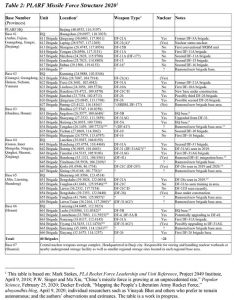
China Table 2
Intercontinental ballistic missiles
China’s current nuclear modernization program, which began in the 1990s, is part of a transition from older, transportable, liquid-fuel, slow-launching missiles to longer-range, road-mobile, solid-fuel, quicker-launching missiles. China’s last liquid-fuel mobile ICBM—the DF-4 (CSS-3)—is down to a single brigade and probably in the process of being retired. China’s force of approximately 20 liquid-fueled, silo-based ICBMs continues to be upgraded, but their lengthy fueling process makes them vulnerable to attack. Currently two versions are deployed—the DF-5A (CSS-4 Mod 2) and the MIRVed DF-5B (CSS-4 Mod 3)—and a third version known as DF-5C is in development. The Pentagon’s latest report to Congress noted that the DF-5B is capable of carrying up to five MIRVs (US Defense Department 2020a, 56), two more than had been previously assumed. We estimate that half of the DF-5s are currently equipped to carry MIRVs, although it is possible that China intends to equip all of them with MIRVs before the new DF-41 takes over the role in the future.
China debuted its first solid-fueled ICBMs in 2006 with the DF-31 (CSS-10 Mod 1). It is a three-stage, road-mobile missile that is transported in a 15-meter canister on a six-axle transporter-erector-launcher (TEL). The DF-31 has a range of about 7,200 kilometers (km) but cannot reach the continental United States from its deployment areas in China.[ii] It is presumed to have taken over much of the regional targeting (of Russia, India, and Guam) done by the soon-to-be-retired DF-4. Currently, China has only a single DF-31 brigade deployed, with fewer than 10 launchers that might soon be upgraded to the new DF-31AG.
The DF-31A (CSS-10 Mod 2) is an extended-range version of the DF-31, but with an apparently identical launcher. With a range of 11,200 km, the DF-31As have the capability to reach about half of the continental United States. Each DF-31A brigade used to operate just six launchers but have now been upgraded to 12 (Eveleth 2020b). We estimate that the country deploys about 36 DF-31As in three brigades. The DF-31A brigades are being upgraded to the DF-31AG.
Since 2017, China’s road-mobile ICBM modernization effort has focused on replacing the DF-31s and DF-31As with the DF-31AG, a new launcher that carries the same missile as the DF-31A but has improved off-road capability. After it was first displayed in 2017, rumors quickly emerged that the DF-31AG might carry an entirely new ICBM, possibly even one with MIRV capability; however, it seems likely the new launcher carries essentially the same missile as DF-31A. Indeed, a 2018 Defense Department report described the DF-31AG as “an enhanced version of the DF-31A ICBM that also uses a transporter-erector-launcher to increase its mobility and survivability” (US Defense Department 2018a, 76).
The next phase of China’s ICBM modernization is the integration of the long-awaited DF-41 ICBM (CSS-20), which has been reportedly in development since 1997. Eighteen DF-41s were mobilized for China’s 70th National Day parade in October 2019; the 16 that were displayed were said to come from two brigades (New China TV 2019). The DF-41s are not yet operational but are being integrated into the first brigades. The US Defense Department believes that this missile is capable of carrying MIRVs (US Defense Department 2019, 45), and rumors have spread in the media that the DF-41 can carry six to 10 warheads (Gertz 2016). Such rumors are often exaggerated, and the number of warheads that the DF-41 can carry may be significantly less—perhaps three—and the additional payload capability may be reserved for decoys and penetration aids to overcome the US ballistic missile defense system. The DF-41 is expected to eventually replace the aging DF-5 and could potentially be launched from silos and railcars, in addition to mobile TELs (US Defense Department 2019, 45). The possibility of a silo-launched DF-41 would be consistent with recent discovery of construction of several new types of silos in the Jilantai training area in Inner Mongolia (Kristensen 2019b). There are also reports of possible silo construction in the 662 Brigade area in Henan province (LaFoy and Eveleth 2020).
Land-based medium- and intermediate-range ballistic missiles
For years, the DF-21 missile family constituted China’s primary regional nuclear-capable system. The DF-21A (CSS-5 Mod 2) is a two-stage, solid-fuel, road-mobile, medium-range ballistic missile with a range of about 2,150 km (the unclassified range is 1,750 km). Since 2016, China has been fielding a new version, the CSS-5 Mod 6, possibly known as DF-21E. The new Mod designation indicates it carries an enhanced missile. We estimate that China has approximately 40 launchers for the nuclear DF-21A/E. China has also deployed two conventional versions: the DF-21C (CSS-4 Mod 4) land-attack missile and the DF-21D (CSS-5 Mod 5) anti-ship missile.
Over the past four years, the primacy of the DF-21 among China’s regional nuclear forces has been overtaken by the DF-26 intermediate-range ballistic missile in significant numbers. The DF-26, which is dual-capable and launched from a six-axle road-mobile launcher, was displayed during a parade in 2016, and the first brigade stood up in April 2018 outside Xinyang in Henan Province (Ministry of National Defense of the People’s Republic of China 2018). In its annual reports, the Pentagon states that over the past three years, the DF-26 force has grown from 16 to 30 launchers in 2018, to 80 launchers in 2019 (which probably was the upper end of a range estimate of 55 to 80), to 200 launchers in 2020 with “more than 200 missiles” (US Defense Department 2020a, 59). We believe that the 200 number may be a typo, and that the actual number of launchers is closer to 100, which better fits the base infrastructure and is also the number listed by a recent US Indo-Pacific Command briefing (Kristensen 2020a).
The majority of the dual-capable DF-26s serve a conventional mission, including an anti-ship variant, and are probably not assigned nuclear warheads. But a small number of launchers, perhaps 20, might serve a regional nuclear role alongside the DF-21. We estimate that four or five DF-26 brigades have become operational, and several more are in the process of standing up (see Table 2).
Like the existing DF-4 and DF-31 ICBMs, the 4,000-km range DF-26 is capable of targeting important US bases in Guam. The DF-26 was reported to be operating in a new training area in Inner Mongolia in January 2019 (Kristensen 2019a) and has been seen at several other brigades (Kristensen 2020b). Unlike the DF-4 and DF-31, however, the DF-26 is both dual-capable and more accurate, and so could provide China with its first precision nuclear strike capability. The 2020 Pentagon report identifies an anti-ship variant of the DF-26 (US Defense Department 2020a, 73).
The dual-capable role of the DF-26 (and also the DF-21) raises some thorny issues about command and control and the potential for misunderstandings in a crisis. Preparations to launch (or the actual launch of) a DF-26 with a conventional warhead against a US base in the region could potentially be misinterpreted as a launch of a nuclear weapon and trigger nuclear escalation (or even preemption). The mixing of nuclear and conventional capability on medium- and intermediate-range ballistic missiles has been implemented in China, India, and Pakistan. Citing a 2017 Chinese defense industry publication, the US Defense Department also hypothesizes that the DF-26 might eventually be used to field a lower-yield warhead (US Defense Department 2020a, 88), although no evidence is provided that China has plans to do so.
Finally, the 70th National Day parade in October 2019 saw the debut of China’s DF-17 hypersonic boost-glide missile. Sixteen launchers were displayed and presented by the official announcer as serving a conventional role in the PLA Rocket Force’s mission (New China TV 2019). However, unofficial sources connected to the Chinese defense industry have claimed that the missile will be dual-capable (Huang 2019), and during Senate testimony the commander of US Strategic Command listed the DF-17 as a “strategic nuclear system” (Richard 2020a, 4). The DF-17 is not yet operational.
Land-based short-range ballistic missiles
Despite many unsubstantiated Internet rumors to the contrary, we estimate that all of China’s short-range ballistic missiles are conventional, with possibly one exception: the DF-15 (CSS-6). After reporting that the nuclear test China conducted on August 16, 1990, may have been “related to development of a warhead for a Chinese short-range ballistic missile” (CIA 1990, 1), the CIA concluded three years later “that China will begin to field nuclear-armed CSS-X-6s next year.” The 1993 memorandum went on, “China almost certainly has already developed the warhead for this system. Testing might be needed for formal weaponization or for additional warhead options” (CIA 1993, 5). Despite the apparent nuclear capability China developed at that time, though, it is unclear whether it ever completed and fielded a nuclear warhead for the DF-15. The 2020 Defense Department report to Congress lists the DF-15 as a conventional missile (US Defense Department 2020a, 55). If so, it is possible China might have developed the capability but never fielded it.
Submarines and sea-based ballistic missiles
China has launched six Jin-class (Type 094) nuclear-powered ballistic missile submarines (SSBNs), which are based at the Longposan naval base near Yulin on Hainan Island. Only four are currently operational. The two newest SSBNs—which were handed over to the PLA Navy in April 2020—are believed to be variants of the original Type 094 design, known as the Type 094A. These boats include a more prominent hump (Sutton 2016), which has triggered some speculation as to whether they could carry up to 16 JL-2 (CSS-N-14) submarine-launched ballistic missiles (SLBMs), instead of the usual 12 (Suciu 2020). However, satellite images confirm that the new subs are equipped with 12 launch tubes each (Kristensen and Korda 2020b).
Each JL-2 is equipped with a single warhead and, possibly, penetration aids. The JL-2, which is a modified version of the DF-31, is thought to have a range of approximately 7,200 km, although US range estimates have varied over the years. Such a range would be sufficient to target Alaska, Guam, Hawaii, Russia, and India from waters near China—but unless the submarine carrying the missile sailed deep into the Pacific Ocean, it could not target the continental United States.
Although the Jin-class is more advanced than China’s first experimental SSBN—the single and now inoperable Xia (Type 092)—it is still a very noisy design; it is suspected that the Type 094 remains two orders of magnitude louder than the top Russian or American SSBNs (Coates 2016). For that reason, China would face constraints and challenges when operating its SSBN force in a conflict (Kristensen 2009). It therefore seems likely that China will end production after its now-completed six boats and turn its efforts to developing the quieter third-generation (Type 096) SSBN, which is scheduled to begin construction in the early 2020s. The completion of a new construction hall at Huludao, where the PLA Navy’s submarines are built, indicates that work may soon begin on the Type 096, which is expected to be larger and heavier than the Type 094 (Sutton 2020). Given that China’s SSBNs are assumed to have approximately a 40-year service life, the US Defense Department expects that the Type 094 and Type 096 boats will operate concurrently (US Defense Department 2020a, 86). If so, that could potentially result in a future fleet of eight to 10 SSBNs.
It remains uncertain whether Jin-class submarines have ever sailed on deterrent patrols with nuclear weapons on board. US Chief of Naval Operations Vice Admiral Joseph Mulloy said in early 2015 that one Chinese SSBN had gone on a 95-day patrol (Osborne 2015). In late 2015, commander of US Strategic Command Admiral Cecil Haney said Chinese SSBNs had been at sea and that, although he did not know if they had nuclear weapons on board, he had to assume that they did (Gertz 2015). In early 2016, the head of the US Defense Intelligence Agency said that the Chinese navy had “deployed the Jin-class nuclear-powered ballistic missile submarine in 2015” on an extended patrol far from Chinese waters (Stewart 2016, 12). Moreover, satellite photos of the SSBN base on Hainan Island show that several Jin-class submarines—sometimes all four—are absent. Although this does not prove they sailed on patrol (one or two could potentially be hiding inside the submarine tunnel at the base) or carried nuclear weapons, it shows that the fleet is active. Despite these uncertainties, Western military officials have privately stated that the United States, Japan, Australia, and the United Kingdom “are already attempting to track the movements of China’s missile submarines as if they are fully armed and on deterrence patrols” (Torode and Lague 2019).
To fully develop a survivable sea-based nuclear deterrent, the Chinese SSBN fleet will face several doctrinal, technical, and operational constraints. Although Chinese missile forces frequently practice the procedures required to load warheads onto missiles, China’s Central Military Commission has long resisted handing out nuclear warheads to the armed services to deploy on missiles under normal circumstances. Giving custody of nuclear warheads to deployed submarines during peacetime would constitute a significant change of Chinese policy. Moreover, before doing so, the Central Military Commission and China’s navy would first have to build up experience operating an SSBN force during realistic military operations, which would require development of reliable command-and-control technologies and procedures.
The SSBNs would also need a launch destination. Even if China deployed nuclear-armed SSBNs to sea in a crisis, where would they sail? For a JL-2 to be able to strike targets in the continental United States, a Jin-class SSBN would have to sail across the East China Sea and well into the Pacific Ocean, through dangerous choke points where it would draw attention and be vulnerable to hostile anti-submarine warfare. It seems more likely that during conflict China would keep its Jin-class SSBNs inside a protective “bastion” in the South China Sea. Whenever they put to sea in this region, China’s SSBNs typically appear to be accompanied by a protection detail, including surface warships and aircraft (and possibly attack submarines) capable of tracking adversarial submarines (Torode and Lague 2019).
China’s next-generation Type 096 SSBNs will carry an extended-range SLBM, the JL-3, which unofficial sources speculate might have a range in excess of 9,000 km. Although such a range would allow a submarine to target the northwestern parts of the continental United States from Chinese waters, it would still not be able to target Washington, DC without sailing far past northeast Japan. Chinese media sources describe the JL-3 as “equivalent to or similar to the French M51” SLBM, and note that it has an increased diameter from the JL-2 and includes a carbon fiber casing, which will allow for an extended range (Coates 2020). But we have yet to see official statements about the characteristics and capabilities of the JL-3. The People’s Liberation Army Navy reportedly conducted its first test of the JL-3 in November 2018 (Gertz 2018) and appears to have conducted at least two additional tests since then. The first round of JL-3 tests was conducted using a Type 032 auxiliary test submarine; however, the most recent test of the missile, in December 2019, was rumored to have been conducted from a Type 094 SSBN (Chan 2020). But if the new Type 096 SSBN is larger than the Jin-class and the JL-3 has significantly greater range, then it seems doubtful that a Jin-class would have been capable of launching the JL-3. These tests, as well as the recent nomination of the JL-3 design team for the “National Award for Excellence in Innovation,” indicates that the missile is currently in an advanced stage of development, and is expected to be integrated with the new Type 096 SSBNs perhaps in the mid-2020s (Liu 2020). Some private sources speculate the Type 096 will carry 24 missiles (Chan 2020), but there are no public official sources confirming this. Based upon current and projected missile inventories, it seems more likely that it will carry 12 to 16 missiles; it is still unclear if it will carry MIRVs.
Bombers
China developed several types of nuclear bombs and used aircraft to deliver at least 12 of the nuclear weapons that it detonated in its nuclear testing program between 1965 and 1979. But the PLA Air Force nuclear mission remained officially dormant well into the 2000s, probably because its older bomb-equipped aircraft were unlikely to be useful in the event of a nuclear conflict. Even as recently as 2017, the US Defense Department assessed that the “People’s Liberation Army Air Force does not currently have a nuclear mission” (US Defense Department 2017, 61).
Of course, this did not stop the PLA Air Force from maintaining a residual capability to deliver nuclear weapons from bombers, and various Chinese military museums display a variety of shapes of what are said to be strategic and tactical nuclear bombs (globalsecurity.org; CTBTO 2020). A Defense Intelligence Agency brief in 1984 estimated China had about 165 nuclear bombs for aircraft, although the agency also stated, “we are unable to identify associated airfield storage sites” (US Defense Intelligence Agency 1984, 3–4). By the early-1990s, the agency reduced the estimate to 75 bombs, but said H-6 (Tu-16) and H-5 (Tu-28) medium-range bombers and A-5 fighter-bombers were “all capable of delivering nuclear weapons” (US Defense Intelligence Agency 1991, 3). And the US National Security Council informed Congress in 1993: “The Chinese Air Force has no units whose primary mission is to deliver China’s small stockpile of nuclear bombs. Rather, some units may be tasked for nuclear delivery as a contingency mission” (National Security Council 1993, 2).
Coinciding with a renewed emphasis on nuclear aircraft modernization, the US Defense Department reported in 2018 that the PLA Air Force “has been newly re-assigned a nuclear mission” and that the “H-6 and future stealth bomber could both be nuclear capable” (US Defense Department 2018a, 75, 34). The 2019 report references unidentified “Chinese media” sources that have apparently labelled the upgraded H-6K as a “dual nuclear-conventional bomber” since 2016 (US Defense Department 2019, 41). The US Defense Department’s Nuclear Matters Handbook from February 2020 lists the H-6 as nuclear and states that the aircraft could be completely fielded within 10 years (US Defense Department 2020b, 3). We estimate that for years China has maintained a small inventory of gravity bombs—perhaps up to 20—for potential contingency use by aircraft, even though it only recently assigned units whose primary mission was to deliver them.
In addition to the gravity bombs, the Defense Intelligence Agency reported in 2016 that China was developing two air-launched ballistic missiles (ALBMs) for the H-6 bomber, “one of which might include a nuclear payload” (Stewart 2016, 10). The missile, designated by the United States as CH-AS-X-13, will be carried by yet another modification of the H-6 bomber known as the H-6N BADGER, which made its debut appearance at the October 2019 parade and appears to be entering service with the PLA Air Force. The H-6N’s appearance is distinct from that of the H-6K dual-use bomber in that it is equipped with a nose-mounted in-flight refueling probe (Rupprecht 2019), and includes a modified fuselage that the US Defense Department believes can accommodate the nuclear-capable ALBM, or possibly a drone (US Defense Department 2020a, 51). One of the first bomber units to get an operational nuclear capability might be the 106th Brigade at Neixiang air base in the south-western part of the Henan province (Lee 2020).
The ALBM in development was first tested in December 2016 and again in January 2018 (Panda 2019). The US Defense Department reported in early 2020 that a “TBD [name to be determined] ALBM” is “in research & development within 10 years” (US Defense Department 2020b, 3). Once complete, this nuclear ALBM will, “for the first time, provide China with a viable nuclear ‘triad’ of delivery systems dispersed across land, sea, and air forces” (US Defense Department 2019, 67).
To replace the H-6, China is developing a bomber with longer range and improved capabilities. US officials have stated for several years that the new bomber, known as H-20, will have a nuclear capability (Coats 2018, 7; US Defense Department 2019, 61). In early 2020 the US Defense Department described the H-20 as a “stealth” bomber whose production will begin within 10 years (US Defense Department 2020b, 3).
Cruise missiles
From time to time, various US military publications have asserted somewhat ambivalently that one or more of China’s cruise missiles might have nuclear capability. However, we assess that although China might have developed warhead designs for potential use in cruise missiles, it does not have any active nuclear cruise missiles in its stockpile.
The CIA concluded in 1995 that a Chinese test scheduled for that year “may include warhead testing for … a cruise missile” (CIA 1995). In 2013, a US Air Force Global Strike command briefing listed the CJ-20 air-launched land-attack cruise missile carried by the H-6K as possibly dual-capable (Kristensen 2013). Likewise, in 2009 the Air Force described the DH-10 (now called DF-10) ground-launched cruise missile as “conventional or nuclear,” but in 2017 designated it and all other Chinese air-launched land-attack cruise missiles “conventional” (US Air Force 2017, 37). Even so, a nuclear modernization fact sheet published by the Pentagon in connection with the release of the 2018 Nuclear Posture Review claimed, without identifying them, that China had both air-launched and sea-launched nuclear cruise missiles (US Defense Department 2018b). It is possible, but unconfirmed, that the future H-20 could be equipped with a nuclear cruise missile.
This research was carried out with grants from the John D. and Katherine T. MacArthur Foundation, the New Land Foundation, the Ploughshares Fund, and the Prospect Hill Foundation.
References
Billingslea, M. 2020. “Transcript: Special Presidential Envoy Marshall Billingslea on the Future of Nuclear Arms Control.” Hudson Institute, May 21. https://www.hudson.org/research/16062-transcript-special-presidential-envoy-marshall-billingslea-on-the-future-of-nuclear-arms-control.
Chan, M. 2020. “China nuclear missile development steps up a gear with test of weapon capable of hitting US mainland.” South China Morning Post, January 4. https://www.scmp.com/news/china/military/article/3044674/china-nuclear-missile-development-steps-gear-test-weapon.
CIA. 1990. “China: New Nuclear Test [Deleted].” Science and Weapons Review, SW SWR 90-048C, July 31, p. 1. Partially declassified and released to the National Security Archive by the CIA’s Directorate of Intelligence, Office of Scientific and Weapons Research under a Freedom of Information Act request.
CIA. 1993. “China’s Nuclear Weapons: Facing Prospects for a Comprehensive Test Ban.” Intelligence Memorandum 93-20044C M, McLean, VA, September 30, p. 5. Partially declassified and released to the National Security Archive by the CIA’s Office of Scientific and Weapons Research under a Freedom of Information Act request.
CIA. 1995. “China: Nuclear Test [Deleted].” National Intelligence Digest, CPAS NID 95-053CX, McLean, VA, March 7, p. 11. Partially declassified and released to the National Security Archive by the National Intelligence Council under a Freedom of Information Act request.
Coates, P. 2016. “Submarine Noise.” Submarine Matters, October 6. https://gentleseas.blogspot.com/2016/10/submarine-noise.html.
Coates, P. 2020. “China’s JL-3 SLBMs utilise carbon fiber booster casings for longer range [translation of original article from SINA News Agency].” Submarine Matters, May 12. https://gentleseas.blogspot.com/2020/05/chinas-jl-3-slbms-utilise-carbon-fiber.html.
Coats, D.R. 2018. Director of National Intelligence. Statement for the Record: Worldwide Threat Assessment of the U.S. Intelligence Community, McLean, VA, March 6. https://www.armed-services.senate.gov/imo/media/doc/Coats_03-06-18.pdf
CTBTO. 2020. “Types of Nuclear Weapons.” No date [accessed September 22]. https://www.ctbto.org/nuclear-testing/types-of-nuclear-weapons/
Davidson, P. 2018. Advanced Policy Questions to the Senate Armed Services Committee, April 17, p. 15. https://www.armed-services.senate.gov/imo/media/doc/Davidson_APQs_04-17-18.pdf
Eveleth, D. 2020a. “Mapping the People’s Liberation Army Rocket Force.” aboyandhis.blog, March 29. https://www.aboyandhis.blog/post/mapping-the-people-s-liberation-army-rocket-force
Eveleth, D. 2020b. “China’s Mobile ICBM Brigades: The DF-31 and DF-41.” aboyandhis.blog, July 2. https://www.aboyandhis.blog/post/china-smobile-
icbm-brigades-the-df-31-and-df-41
Gertz, B. 2015. “Pentagon confirms patrols of Chinese nuclear missile submarines.” Washington Times, December 9. http://www.washingtontimes.com/news/2015/dec/9/inside-the-ring-chinas-nuclear-missile-submarine-p/
Gertz, B. 2016. “China Flight Tests New Multiple-Warhead Missile,” Washington Free Beacon, April 19. http://freebeacon.com/national-security/china-flight-tests-multiple-warhead-missile/
Gertz, B. 2018. “China Flight Tests New Submarine-Launched Missile.” Washington Free Beacon, December 18. https://freebeacon.com/national-security/china-flight-tests-new-submarine-launched-missile/.
GlobalSecurity.org. [No date, accessed May 2018]. “Nuclear Gravity Bombs.” https://www.globalsecurity.org/wmd/world/china/nuke-gravity.htm
Heinrichs, R.L. 2020. “Reject ‘No First Use’ Policy.” The Hudson Institute, August 24. https://www.hudson.org/research/16328-reject-no-first-use-nuclear-policy
Howe, J.R. 2020. “Chinese Strategic Nuclear Force Posture: Current and Future 2025.” Briefing to the Annual Nuclear Deterrence Summit, Alexandria, V.A. February 11-13, slide 29.
Huang, K. 2019. “China’s hypersonic DF-17 missile threatens regional stability, analyst warns.” South China Morning Post, August 23. https://www.scmp.com/news/china/military/article/3023972/chinas-hypersonic-df-17-missile-threatens-regional-stability.
Hudson Institute. 2019. “The Arms Control Landscape: Featuring DIA Lt. Gen. Robert P. Ashley, Jr. on Russian and Chinese nuclear weapons, May 29. https://www.hudson.org/events/1694-the-arms-control-landscape52019
Karber, P.A. 2011, Strategic Implications of China’s Underground Great Wall, Washington, D.C., Georgetown University, September 26. https://fas.org/nuke/guide/china/Karber_UndergroundFacilities-Full_2011_reduced.pdf
Kristensen, H.M. 2006. “DIA Assessment of Chinese Nuclear Forces.” nukestrat.com. http://www.nukestrat.com/china/diachina.htm
Kristensen, H.M. 2009. “China’s noisy nuclear submarines.” FAS Strategic Security Blog, November 21. www.fas.org/blog/ssp/2009/11/subnoise.php
Kristensen, H.M. 2012. “STRATCOM Commander Rejects High Estimates for Chinese Nuclear Arsenal.” FAS Strategic Security Blog, August 22. https://fas.org/blogs/security/2012/08/china-nukes/
Kristensen, H.M. 2013. “Air Force Briefing Shows Nuclear Modernizations But Ignores US and UK Programs.” FAS Strategic Security Blog, May 29. https://fas.org/blogs/security/2013/05/afgsc-brief2013/
Kristensen, H.M. 2019a. “Chinese DF-26 Missile Launchers Deploy To New Missile Training Area.” FAS Strategic Security Blog, January 21. https://fas.org/blogs/security/2019/01/df-26/
Kristensen, H.M. 2019b. “New Missile Silo And DF-41 Launchers Seen In Chinese Nuclear Missile Training Area.” FAS Strategic Security Blog, September 3. https://fas.org/blogs/security/2019/09/china-silo-df41/.
Kristensen. H.M. 2020a. “(The Other) Red Storm Rising: INDO-PACOM China Military Projection.” FAS Strategic Security Blog, September 15. https://fas.org/blogs/security/2020/09/pacom-china-military-projection/
Kristensen, H.M. 2020b. “China’s New DF-26 Missile Shows Up At Base In Eastern China.” FAS Strategic Security Blog, January 21. https://fas.org/blogs/security/2020/01/df-26deployment/.
Kristensen, H.M., and Korda, M. 2020a. “Russian nuclear forces, 2020.” Nuclear Notebook. Bulletin of the Atomic Scientists, 76.2, pp. 102-117. https://www.tandfonline.com/doi/full/10.1080/00963402.2020.1728985
Kristensen, H.M., and Korda, M. 2020b. “The Pentagon’s 2020 China Report.” FAS Strategic Security Blog. September 1. https://fas.org/blogs/security/2020/09/the-pentagons-2020-china-report/
Kulacki, G. 2016. “China’s Military Calls for Putting Its Nuclear Forces on Alert.” Union of Concerned Scientists, January. http://www.ucsusa.org/sites/default/files/attach/2016/02/China-Hair-Trigger-full-report.pdf
Kulacki, G. 2020. “Would China Use Nuclear Weapons First in a War With the United States?” The Diplomat, April 27. https://thediplomat.com/2020/04/would-china-use-nuclear-weapons-first-in-a-war-with-the-united-states/.
LaFoy, S., and Eveleth, D. 2020. “Possible ICBM Modernization underway at Sundian.” Arms Control Wonk, February 5. https://www.armscontrolwonk.com/archive/1208828/possible-icbm-modernization-underway-at-sundian/
Lee, R. 2020. “China’s Air Force Might Be Back in the Nuclear Business.” The Diplomat, September 9. https://thediplomat.com/2020/09/chinas-air-force-might-be-back-in-the-nuclear-business/
Liu, Z. 2020. “China fires its latest underwater nuclear missile into spotlight with science prize.” South China Morning Post, May 12. https://www.scmp.com/news/china/military/article/3084063/china-fires-its-latest-underwater-nuclear-missile-spotlight.
Ministry of Foreign Affairs of the People’s Republic of China. 2019. “Implementation of the Treaty on the Non-Proliferation of Nuclear Weapons in the People’s Republic of China.” Report submitted by China to the Preparatory Committee for the 2020 Review Conference of the Parties to the Treaty on the Non-Proliferation of Nuclear Weapons, Third Session, New York, May 10–29. https://webcache.googleusercontent.com/search?q=cache:QR2PA1IGZW4J:https://papersmart.unmeetings.org/media2/21492272/npt_conf2020_pciii_8-8-final-e-national-report-submitted-by-china_c.pdf+&cd=1&hl=en&ct=clnk&gl=us
Ministry of National Defense of the People’s Republic of China. 2018. “China’s rocket force embraces new medium-long range ballistic missile.” April 16. http://eng.mod.gov.cn/news/2018-04/16/content_4809589.htm.
Ministry of National Defense of the People’s Republic of China. 2020. “China reiterates it will not join so-called China-U.S.-Russia arms control negotiations.” July 9. http://eng.mod.gov.cn/news/2020-07/09/content_4867804.htm.
National Security Council. 1993. “Report to Congress on Status of China, India and Pakistan Nuclear and Ballistic Missile Programs.” https://fas.org/irp/threat/930728-wmd.htm
New China TV. 2019. “China holds grand gathering, parade on 70th National Day.” Xinhua. October 1. https://www.youtube.com/watch?v=dit7zmnzAh0.
Osborne, K. 2015. “Admiral Says China Outnumbers U.S. in Attack Submarines.” DOD Buzz, February 26. http://www.dodbuzz.com/2015/02/26/admiral-says-china-outnumbers-u-s-in-attack-submarines/
Panda, A. 2019. “Pentagon: Air-Launched Ballistic Missile Will Realize China’s Nuclear Triad.” The Diplomat, May 7. https://thediplomat.com/2019/05/pentagon-air-launched-ballistic-missile-will-realize-chinas-nuclear-triad/.
Richard, C. 2020a. Statement before the Senate Committee on Armed Services. February 13. https://www.armed-services.senate.gov/imo/media/doc/Richard_02-13-20.pdf.
Richard, C. 2020b. Testimony before the Senate Committee on Armed Services. February 13. https://www.stratcom.mil/Media/Speeches/Article/2086752/us-strategic-command-and-us-northern-command-sasc-testimony/.
Rupprecht, A. 2019. “Images confirm H-6N bomber variant is in PLAAF service.” Jane’s, September 10. https://janes.ihs.com/Janes/Display/FG_2394418-JDW.
Schneider, M.B. 2019. “The expanding Chinese nuclear threat.” Real Clear Defense, May 6. https://www.realcleardefense.com/articles/2019/05/06/the_expanding_chinese_nuclear_threat_114399.html
Singer, P.W., and Xiu, M. 2020. “China’s missile force is growing at an unprecedented rate,” Popular Science, February 25. https://www.popsci.com/story/blog-eastern-arsenal/china-missile-force-growing/
State Council Information Office of the People’s Republic of China. 2019. “China’s National Defense in the New Era,” July 2019. http://www.xinhuanet.com/english/2019-07/24/c_138253389.htm.
Stewart, V.R. 2016. “Statement for the Record: Worldwide Threat Assessment.” February 9. http://www.armed-services.senate.gov/imo/media/doc/Stewart_02-09-16.pdf
Stokes, M.A. 2010. “China’s nuclear warhead storage and handling system.” Project 2049 Institute, March 12. project2049.net/documents/chinas_nuclear_warhead_storage_and_handling_system.pdf
Stokes, M.A. 2018. “PLA Rocket Force Leadership and Unit Reference.” McLean, VA: Project 2049 Institute, April 9.
Suciu, P. 2020. “China Now Has Six Type 094A Jin-Class Nuclear Powered Missile Submarines.” The National Interest, May 6. https://nationalinterest.org/blog/buzz/china-now-has-six-type-094a-jin-class-nuclear-powered-missile-submarines-151186.
Sutton, H.I. 2016. “New Chinese Type-094A SSBN.” Covert Shores, July 19. http://www.hisutton.com/New%20Chinese%20Type-094A%20SSBN.html.
Sutton, H.I. 2020. “Chinese Navy Steps Closer To New Generation Of Nuclear Submarines.” Forbes, June 19. https://www.forbes.com/sites/hisutton/2020/06/19/chinese-navy-gets-closer-to-new-generation-of-nuclear-submarines/#f93ffed229e5.
Torode, G., and D. Lague. 2019. “Special Report: China’s furtive underwater nukes test the Pentagon.” Reuters, May 2, https://www.reuters.com/article/us-china-army-nuclear-specialreport/special-report-chinas-furtive-underwater-nukes-test-the-pentagon-idUSKCN1S80YB.
US Air Force, National Air and Space Intelligence Center. 2017. “Ballistic and cruise missile threat.” NASIC-1031-0985-17, July (corrected version).
http://www.nasic.af.mil/Portals/19/images/Fact%20Sheet%20Images/2017%20Ballistic%20and%20Cruise%20Missile%20Threat_Final_small.pdf?ver=2017-07-21-083234-343
US Defense Department. 2017. Annual Report to Congress: Military and Security Developments Involving the People’s Republic of China 2017. Office of the Secretary of Defense, May 15. https://www.defense.gov/Portals/1/Documents/pubs/2017_China_Military_Power_Report.PDF
US Defense Department. 2018a. Annual Report to Congress: Military and Security Developments Involving the People’s Republic of China 2018. Office of the Secretary of Defense, May 16. https://media.defense.gov/2018/Aug/16/2001955282/-1/-1/1/2018-CHINA-MILITARY-POWER-REPORT.PDF
US Defense Department. 2018b. Global Nuclear Capability Modernization: Global Nuclear-Capable Delivery Vehicles, Fact Sheet. Office of the Secretary of Defense. https://media.defense.gov/2018/Feb/02/2001872878/-1/-1/1/GLOBAL-NUCLEAR-MODERNIZATION.PDF.
US Defense Department. 2019. Annual Report to Congress: Military and Security Developments Involving the People’s Republic of China 2019. Office of the Secretary of Defense, May 3. https://media.defense.gov/2019/May/02/2002127082/-1/-1/1/2019_CHINA_MILITARY_POWER_REPORT.pdf.
US Defense Department. 2020a. Annual Report to Congress: Military and Security Developments Involving the People’s Republic of China 2019. Office of the Secretary of Defense, September 1. https://media.defense.gov/2020/Sep/01/2002488689/-1/-1/1/2020-DOD-CHINA-MILITARY-POWER-REPORT-FINAL.PDF.
US Defense Department. 2020b. Nuclear Matters Handbook 2020, Office of the Deputy Assistant Secretary of Defense for Nuclear Matters, February. https://www.acq.osd.mil/ncbdp/nm/nmhb/docs/NMHB2020.pdf
US Defense Intelligence Agency. 1984. Nuclear Weapons Systems in China, Defense Estimative Brief DEB-49-84, April 24. Document reconstructed from different FOIA releases. http://www.nukestrat.com/china/DIA042484re.pdf
US Defense Intelligence Agency. 1991. Chinese Strategic Forces, not dated but probably December 1991. http://www.dia.mil/FOIA/FOIA-Electronic-Reading-Room/FOIA-Reading-Room-China/FileId/39740/
US Defense Intelligence Agency. 1999. The Decades Ahead: 1999-2020. July, p. 38. Classified document reproduced in Scarborough, R. 2004. Rumsfeld’s War: The Untold Story of America’s Anti-Terrorist Commander. Washington, D.C.: Regnery Publishing, p. 197.
US State Department. 2020. 2020 Adherence to and Compliance with Arms Control, Nonproliferation, and Disarmament Agreements and Commitments, Bureau of Arms Control, Verification and Compliance. June. https://www.state.gov/wp-content/uploads/2020/06/2020-Adherence-to-and-Compliance-with-Arms-Control-Nonproliferation-and-Disarmament-Agreements-and-Commitments-Compliance-Report-1.pdf.
Notes
[i] Nuclear weapons are stored in central facilities under the control of the Central Military Commission. Should China come under nuclear threat, the weapons would be released to the Second Artillery Corps to enable missile brigades to go on alert and prepare to retaliate. For a description of the Chinese alerting concept, see Kristensen (2009a). For more on warhead storage in China, see Stokes (2010). For an overview of the PLA Rocket Force structure and organization, see Stokes (2018).
[ii] The “continental United States” as used here includes only the lower 48 states. US states and territories outside of the continental United States include Alaska, Hawaii, Guam, American Samoa, and many tiny Pacific islands.
منبع:https://thebulletin.org/premium/2020-12/nuclear-notebook-chinese-nuclear-forces-2020/




























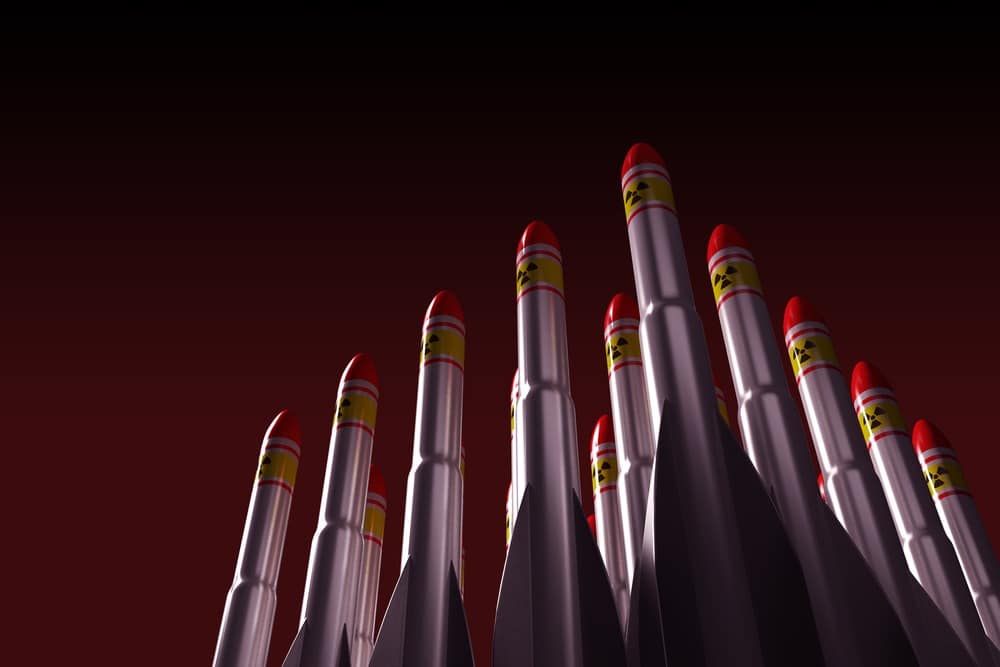
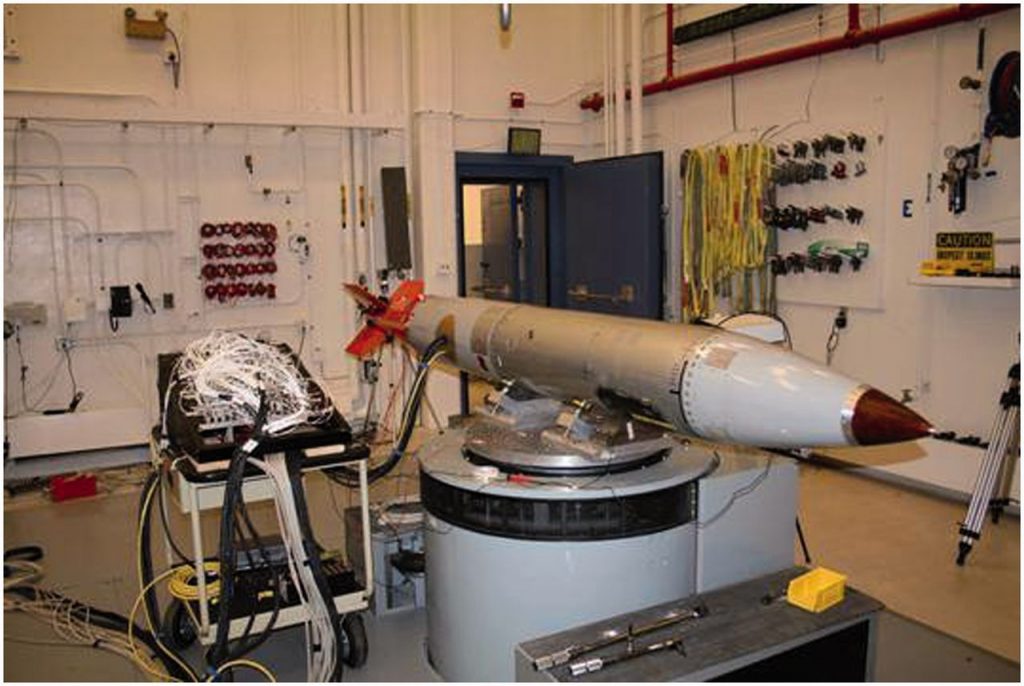

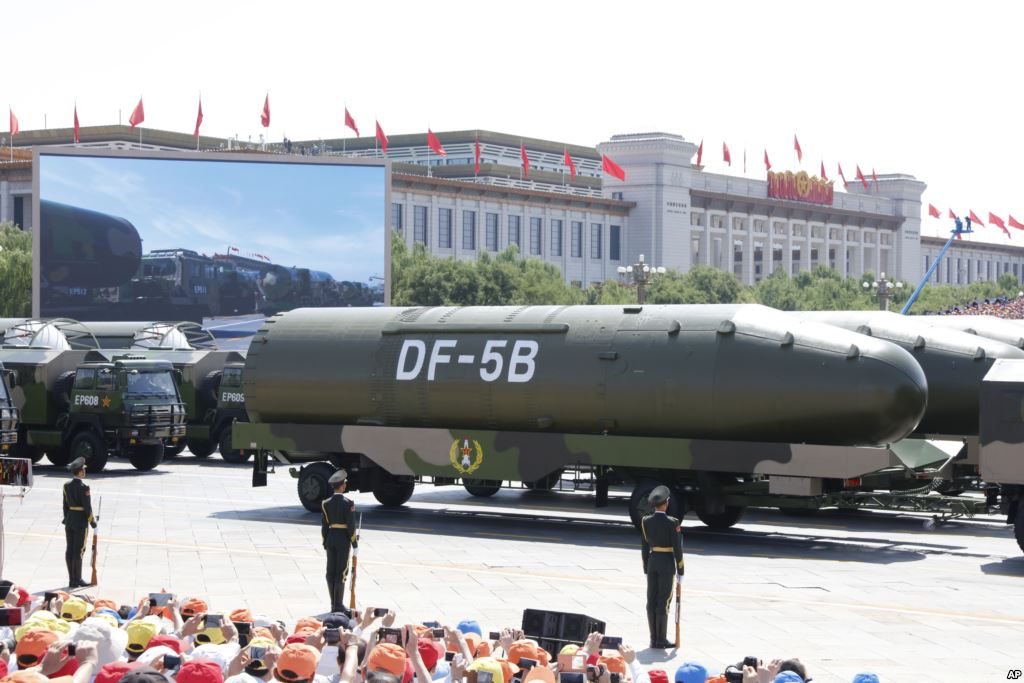 A Chinese intercontinental ballistic missile at a 2015 military parade in Beijing. China may be a source for other governments wishing to buy missiles. (Photo credit: Voice of America via Wikimedia Commons.)
A Chinese intercontinental ballistic missile at a 2015 military parade in Beijing. China may be a source for other governments wishing to buy missiles. (Photo credit: Voice of America via Wikimedia Commons.)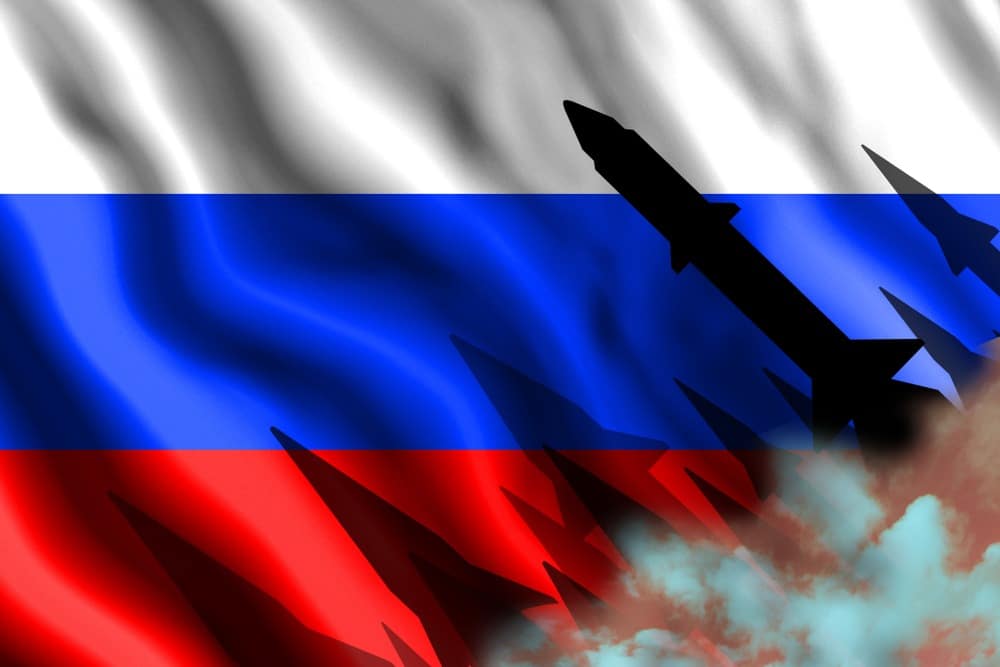

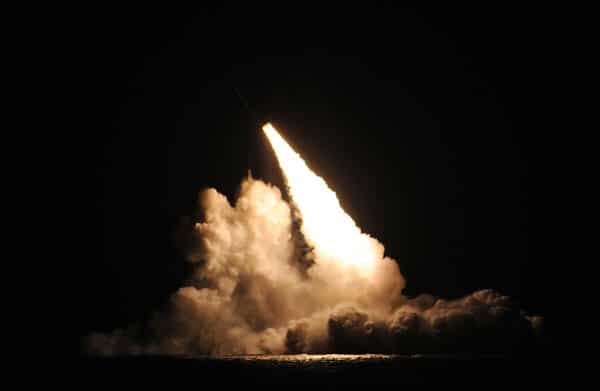 If developed, a low-yield nuclear warhead for US submarine-launched ballistic missiles will increase the likelihood of nuclear war.
If developed, a low-yield nuclear warhead for US submarine-launched ballistic missiles will increase the likelihood of nuclear war.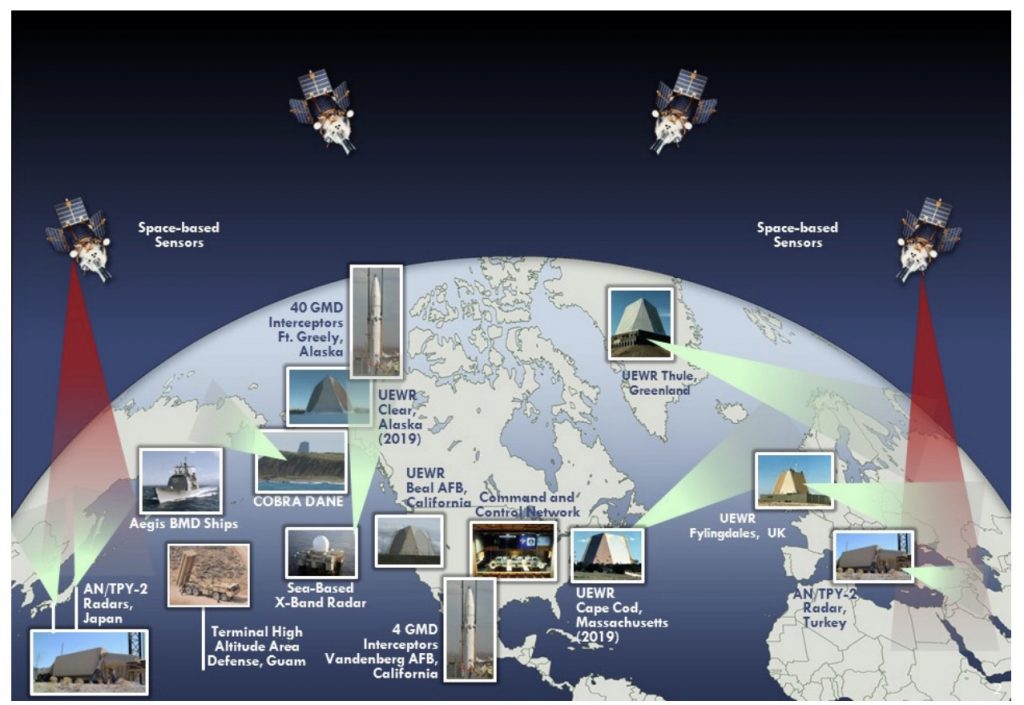 Current homeland missile defense architecture. (UEWR = upgraded early warning radar.)
Current homeland missile defense architecture. (UEWR = upgraded early warning radar.)

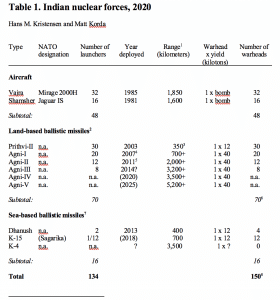

 The French aircraft carrier Charles De Gaulle. Credit: US Navy via Wikimedia Commons.
The French aircraft carrier Charles De Gaulle. Credit: US Navy via Wikimedia Commons.


